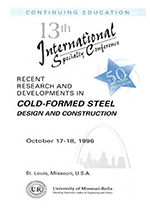Session Dates
17 Oct 1996
Abstract
The compressional behaviour of stub columns having perforations in the form of slots of different length is examined on the basis of testing. Plain channels of a specified geometry are considered, and the geometry examined follows that of a test programme previously carried out to examine the effects of perforation location on stub column strength. Two different perforation layouts, and two material thicknesses are considered and systematic variation in the slot length is carried out for each layout and thickness. It is found that the stub column compression capacity reduces as the perforation length increases. The test results are compared with design code predictions and with modified predictions set up to take the perforations, and perforation lengths, into account.
Department(s)
Civil, Architectural and Environmental Engineering
Research Center/Lab(s)
Wei-Wen Yu Center for Cold-Formed Steel Structures
Meeting Name
13th International Specialty Conference on Cold-Formed Steel Structures
Publisher
University of Missouri--Rolla
Document Version
Final Version
Rights
© 1996 University of Missouri--Rolla, All rights reserved.
Document Type
Article - Conference proceedings
File Type
text
Language
English
Recommended Citation
Rhodes, J. and MacDonald, M., "The Effects of Perforation Length on the Behaviour of Perforated Elements in Compression" (1996). CCFSS Proceedings of International Specialty Conference on Cold-Formed Steel Structures (1971 - 2018). 4.
https://scholarsmine.mst.edu/isccss/13iccfss/13iccfss-session1/4
The Effects of Perforation Length on the Behaviour of Perforated Elements in Compression
The compressional behaviour of stub columns having perforations in the form of slots of different length is examined on the basis of testing. Plain channels of a specified geometry are considered, and the geometry examined follows that of a test programme previously carried out to examine the effects of perforation location on stub column strength. Two different perforation layouts, and two material thicknesses are considered and systematic variation in the slot length is carried out for each layout and thickness. It is found that the stub column compression capacity reduces as the perforation length increases. The test results are compared with design code predictions and with modified predictions set up to take the perforations, and perforation lengths, into account.



